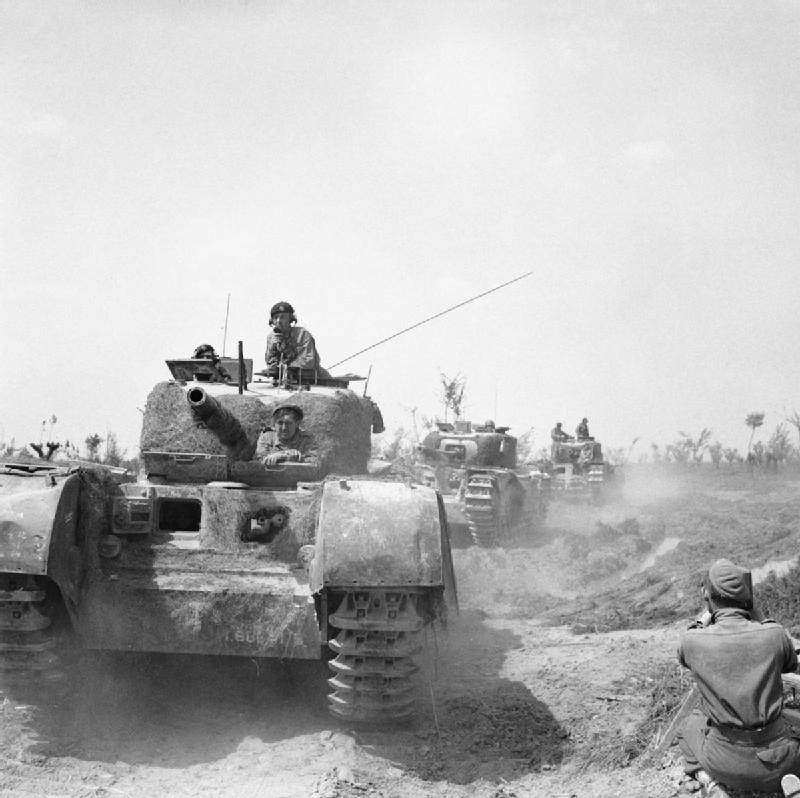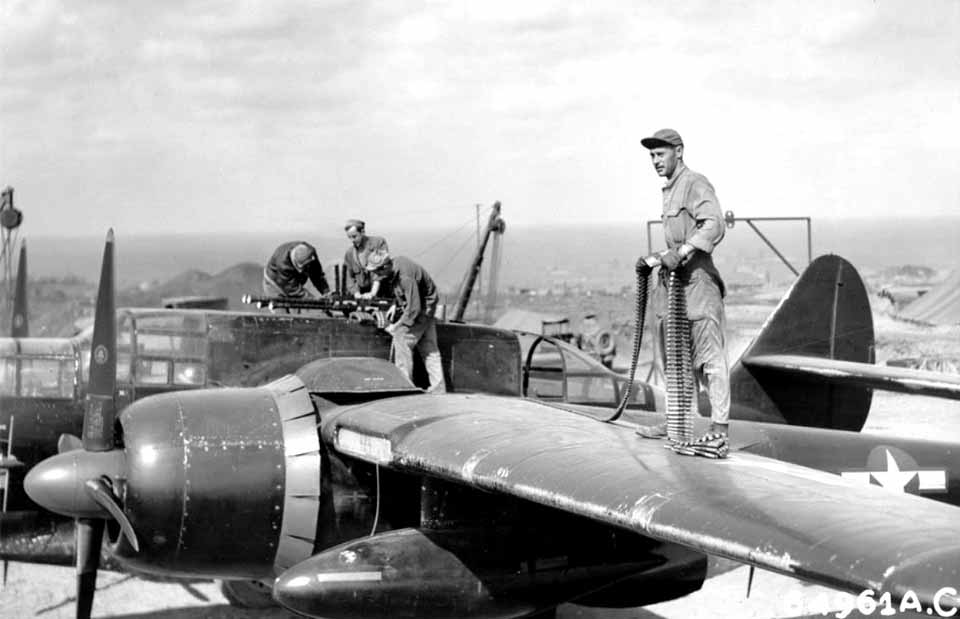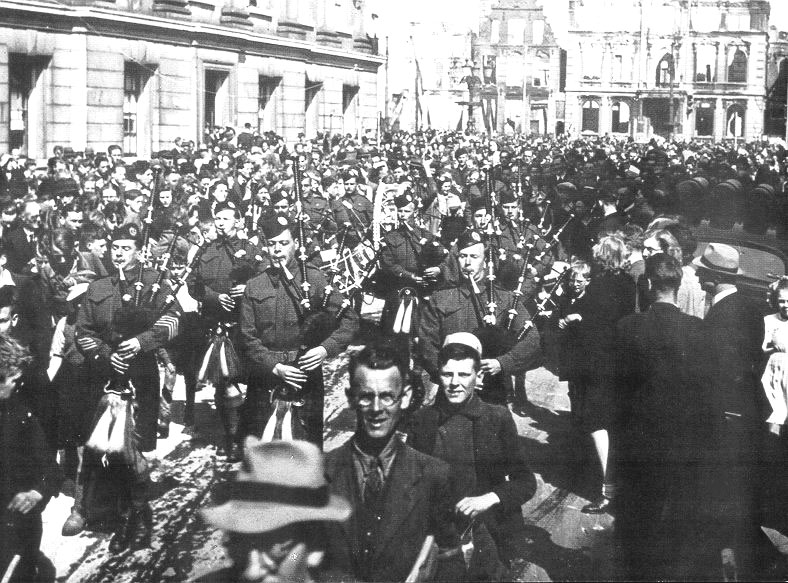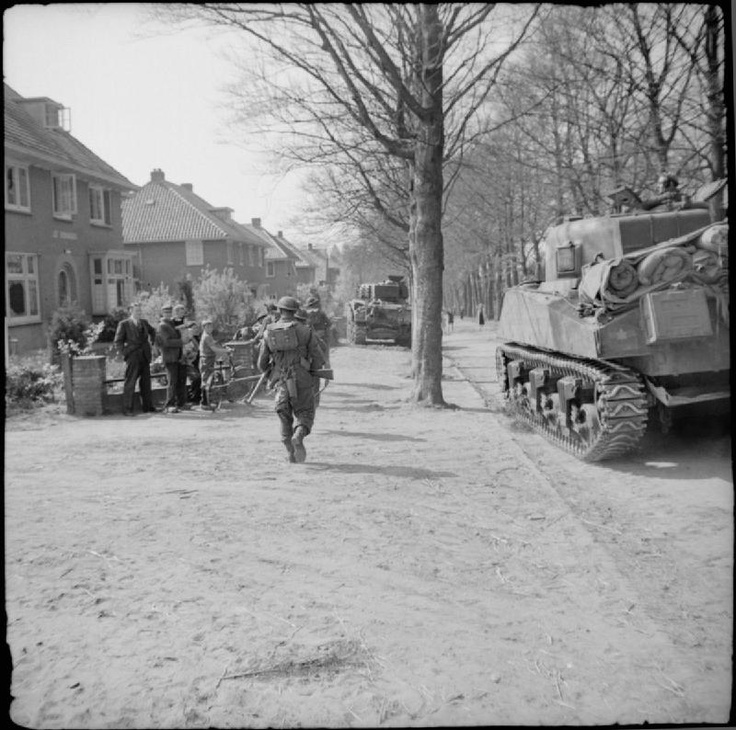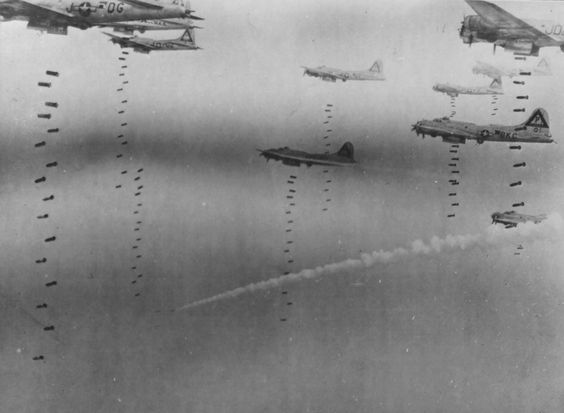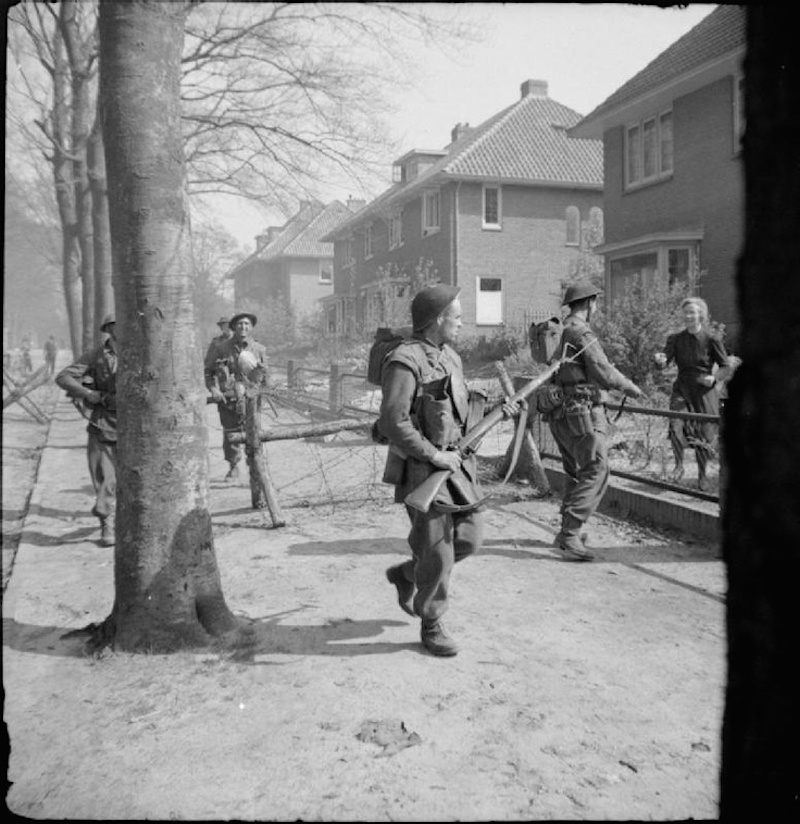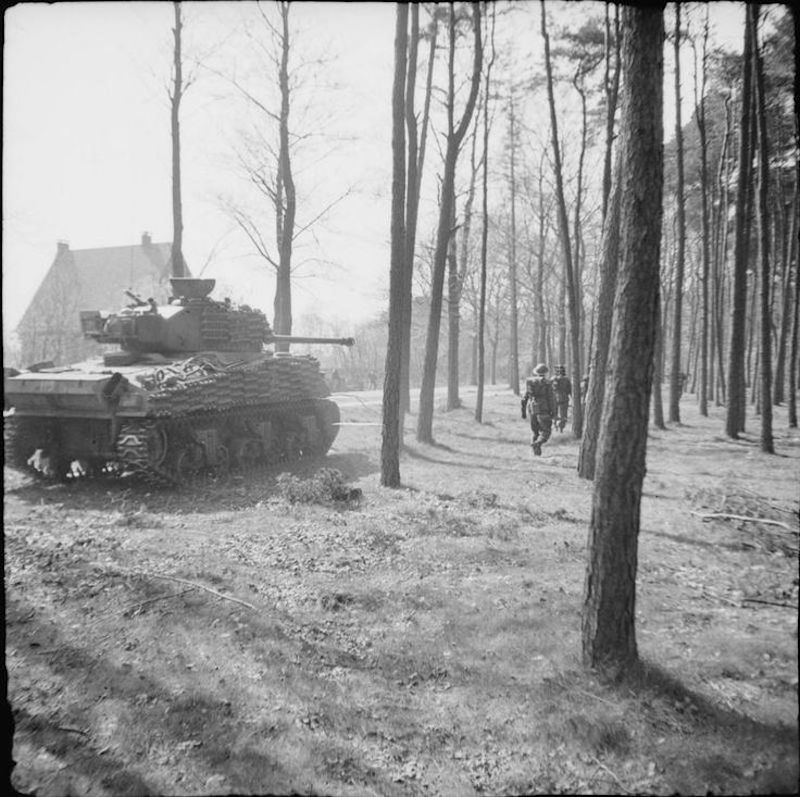Air Operations, CBI
BURMA- 18 10th Air Force fighter-bombers attack troops and supplies at 1 locations.
- 12 fighter-bombers attack road targets immediately behind the Japanese Army battle lines.
- 2 308th Heavy Bomb Group B-24s attack the Bakli Bay port area.
- 6 341st Medium Bomb Group B-25s attack Liang-feng.
- 4 B-25s and 4 14th Air Force P-51s attack river shipping near Yiyang.
- More than 70 fighter-bombers attack targets across southern and eastern China.
Air Operations, Europe
RAF BOMBER COMMANDEvening Ops:
- 90 Lancasters and 11 Mosquitos of No. 5 Group attack the railway yards in the small town of Cham deep in southeastern Germany. The attack is completely successful with tracks torn up and rolling stock destroyed.
- There are no losses.
- 61 Mosquitos are sent to Berlin and 43 to Ingoldstadt airfield, and there are 40 Mosquito patrols and 28 RCM sorties.
- 2 Mosquitos are lost on the Berlin raid.
- Mosquitoes bomb the Gestapo Headquarters at Odense, Denmark.
CZECHOSLOVAKIA:
- 61 2nd Air Division B-24s attack rail targets at Beroun.
- 36 2nd Air Division B-24s attack rail targets at Kladno.
- 115 3rd Air Division B-17s attack an ordnance depot and a marshalling yard at Roudnice.
- 428 1st Air Division B-17s attack a rail center and marshalling yard at Dresden.
- 92 2nd Air Division B-24s attack rail targets at two locations near the Czech-German border.
- 162 3rd Air Division B-17s attack rail targets in Dresden.
- 87 3rd Air Division B-17s attack rail targets at Aussig.
- 9th Air Force fighters and fighter-bombers attack two airfields.
- 9th Air Division bombers attack the city of Magdeburg and two marshalling yards and three ordnance depots.
- 9th and 1st Tactical Air Force fighter pilots down 28 Luftwaffe fighters over Germany between 0700 and 1515 hours.
- 12th Air Force B-25s provide direct support for the British 8th Army, and attack four bridges across the Reno River, and bridges on both sides of the Austro-Italian border near the Brenner Pass.
- XXII TAC P-47s provide support for the US 5th Army's drive on Bologna.
- During the night, XXII TAC A-20s and A-26s attack lines of communication in the Po River valley and three defended towns on the US 5th Army front.
- 147 15th Air Force P-38 dive-bombers attack two rail bridges.
- 15th Air Force B-17s and B-24s mount 751 effective sorties against supply dumps, gun emplacements, German Army headquarters, and troop concentrations in the US 5th Army zone south and southwest of Bologna.
- 22nd, 43rd, 90th, and 380th Heavy Bomb group B-24s attack the airfields at Okayama, Shinshoshi, Taichu, and Toyohara.
- 18 38th Medium Bomb Group B-25s attack the Taito airfield.
- XIII Bomber Command B-24s attack Cotabato and Kabacan on Mindanao.
- 42nd Medium Bomb Group B-25s sweep highways and roads on Mindanao.
- FEAF B-24s, B-25s A-20s, and fighter-bombers, and 1st Marine Aircraft Wing SBDs and F4Us attack targets throughout the Philippine Islands and Sulu Archipelago.
- Following an intense 6-day air and naval bombardment of the region, the US 8 Army’s X Corps lands without opposition at Parang on Mindanao’s west coast. Cover is provided by 35 1st Marine Aircraft Wing SBDs and 30 F4Us, which also sweep highways ahead of the advancing troops.
- US Navy and Marine Corps aircraft support the US 10th Army on Okinawa and Ie Shima.
- Task Force 57 aircraft attack airfields in the Sakishima Islands before retiring to refuel.
- A VF-17 F6F downs a G4M 'Betty' bomber at sea at 0015 hours.
- VF-83 F6F downs a G4M 'Betty' at sea at 0130 hours.
- VF-9, VF-12, and VF-47 F6Fs down 34 Japanese fighters at sea and near Kikai Shima at 0830 hours.
- VBF-9 F6Fs down 4 Ki-43 'Oscar' fighters 42 miles from Task Force 58 at 0855 hours.
- VF-46 F6Fs down 3 D4Y 'Judy' diver bombers 40 miles from Task Force 58 at 0900 hours.
- A VMF-311 F4U and a VBF-83 F4U each downs an A6M Zero at sea at 0915 hours.
- VF-84 F4Us down a G4M 'Betty' bomber and a Ki-84 'Frank' fighter near US picket destroyers at 0930 hours.
- VBF-9 F6Fs down 2 Ki-61 'Tony' fighters and a VF-84 F6F downs a G4M 'Betty' bomber 43 miles from Task Force 58 at 0945 hours.
- A VBF-9 F6F downs a P1Y 'Galaxy' bomber 13 miles from Task Force 58 at 1425 hours.
- A VMF(N)-543 F6F downs a Ki-21 'Sally' bomber over Naha, Okinawa, at 2130 hours.
- The Japanese submarine RO-46 is sunk by the US submarine Sea Owl in the Central Pacific area.
- Mines sink the Japanese guardboat No.92 Banshu Maru off Goto Rette and the Japanese cargo ship Sonjo Maru (800t) off Shanghai.
-
GERMANY:
CZECHOSLOVAKIA:
ITALY:
AUSTRIA:
Air Operations, Formosa
Air Operations, Japan
In an effort to defeat the kamikaze campaign at its sources, 118 XXI Bomber Command B-29s attack the Izumi airfield on Honshu and the Kanoya, Kokubu, Nittagahara, and Tachiarai airfields on Kyushus. This interdiction campaign will account for nearly 75 percent of all XXI Bomber Command B-29s sorties through May 11, 1945.
[Air Operations, Pacific
B-29s carry of the first of a series of raids on 17 kamikaze bases in southern Japan. These raids continue until May 11.
[Air Operations, Philippines
Air Operations, Ryukyus
Allied Planning
Gen Eisenhower' directive for the final operations in Germany is passed to subordinate commanders. With German now split in half, the Allied forces in the west will attack to the north and south to eliminated the last resistance. The Elbe River is the halt line for farther advaces eastward. The 12th Army Group is to defend the Elbe-Mulde River line while 3rd Army is to attack southward toward Nürnberg and Regensburg and into the Danube River valley. The 6th Army Group is to occupy western Austria and the adjacent territory of Germany within its area of responsibility. The 21st Army Group is to cross the Elbe, secure Hamburg and advace to the Baltic toward Kiel and be prepared to attack into Denmark.
[Diplomatic Relations
The US promises the Soviet Union an additional 5,700,000 tons of supplies.
[Eastern Front
The great battle for Berlin develops. The biggest breakthroughs are made by the 1st Ukraine Front over the Neisse, where 3 Russian armies are advancing rapidly toward the Spree River, driving back the 4th Panzer Army. The Army Group Center loses ground in the south where the Russians advance on Brno, but contains the enemy near Ratibor and Loslaw. On the front held by the Vistula Army Group there are violent clashes south of Frankfurt-on-the-Oder, where the Russian 33rd Army, 1st Belorussian Front, is advancing.
In East Prussia, the remains of the German 2nd and 4th Armies have succeeded in retiring west of Königsberg in the area of Pillau, where they suffer heavy casualties from Russian air attacks.
On the Austrian front, the position of the 6th SS Panzer Army grows steadily worse south of St Pölten. Russian troops capture Wilhelmsburg.
GERMANYAlthough the Soviet 8th Guards Army captures Seelow late in the afternoon, the German 9th Army retires to another defense line. The Soviets have suffered heavy casualties. The 1st Ukrainian Front is across the Neisse and has pushed back the 4th Panzer Army. Its 3rd Guards Tank and 4th Guards Tank Armies are now heading toward Zossen and Potsdam.[MORE]
[Italy
All 8th Army units are now making fine progress in the continuing Allied offensive. On the right Argenta falls to V Corps with help from an amphibious move across Lake Comachio. North and east of Argenta there are no more rivers before the Po and the British units are soon passing through this 'Argenta Gap'. West of Argenta XIII Corps has now come into the line between V Corps and the Poles who are themselves moving northwest toward Bologna. 5th Army attacks are also continuing, but with slightly slower progress because of the more difficult terrain south and west of Bologna. In the western sector, the 92nd Div, US 5th Army, makes for Sarzana, while the IV Corps reaches Monte Ferra and Monte Moscoso.
[Okinawa
The 6th Marine Div, III Amphibious Corps, takes the summit of Yae-Take, in the Motobu peninsula, having finally broken the Japanese. Meanwhile the Americans reinforce their line in the south. Facing the Shuri line there are now the 7th, 96th and 27th Divs of Gen Hodges's XIV Corps, and supporting fire is given by 650 Marines aircraft, 27 groups of artillery, 6 battleships, 6 cruisers and 9 destroyers.
The US destroyer Benham (DD-796) is damaged by a kamikaze and by friendly fire in the Okinawa area.
On Ie Shima the US 77th Div advances toward Mount Iegusugu, which dominates the whole island, and toward Ie, the chief town, where they reach the outskirts. The Japanese garrison in the northeast of the island puts up a particularly stiff resistance.
[Pacific
Philippines
On Luzon in the US I Corps sector, the 37th Div reaches the Irisan River and comes up against the last Japanese defense line before Baguio. The Japanese hold out for several days. The 32nd Div goes on mopping up in the hills around the Salacsac Pass, in the Villa Verde track. The Japanese are still defending the Kapintalan area very vigorously. In the XI Corps sector, the 6th Div eliminates the last Japanese resistance on Mount Mataba. In the XIV Corps sector, the US 1st Cav Div makes a little progress on the western slopes of Mount Mataasna Bundoc, the last major enemy position in the central southern part of Luzon.
Assault units of the 24th Div, Gen Franklin C. Sibert's US X Corps, supported by aircraft, cruisers and destroyers from a force led by Adm Albert G. Noble, land on Mindanao Island, in the area of Cotabatu on the west coast. The landing force makes rapid progress, meeting with no opposition from the Japanese 35th Army under Gen Sosaku Suzuki, and takes Parang and the hills overlooking Polloc Harbor. The town of Malabang has already been liberated by guerrillas. The US forces which have landed at Zamboanga early in March have already cleared a large part of the southwest of the island.
On Cebu, the Americal Div occupies the positions evacuated by the Japanese on the hills around Cebu City. In the Sulu archipelago, Jolo Island is almost wholly liberated from the Japanese except for Mount Daho, which is hammered by aircraft, guns and mortars.
[Western Front
The British XXX Corps, 2nd Army, is still battling in the suburbs of Bremen, while at Ülzen the VIII Corps is still on the same positions as on the previous day. The XIX Corps, US 9th Army, begins the assault on Magdeburg, on the west bank of the Elbe.
In the Ruhr pocket the XVIII Airborne Corps reaches Duisburg, Solingen, Düsseldorf and Werden, while the III Corps continues to collect the prisoners of war and prepares to be transferred to the US 3rd Army sector. The VII Corps consolidates its positions in the area between the Mulde River in the west and the Elbe in the north.
The 2nd and 9th Divs of the V Corps are approaching Leipzig.
The divisions of the XV Corp, US 7th Army, converge on Nuremberg and begin the battle for the city, meeting with fierce resistance.
In the French 1st Army sector the II Corps takes Freudenstadt and cuts the German 19th Army in two.
[Images from April 17, 1945
|
|
|
|
|
|
|
|
